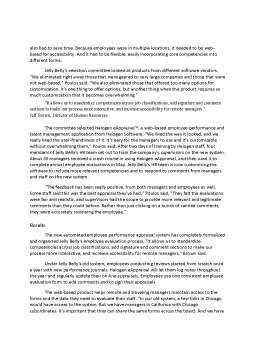Cuprins
- Chapter 1:Introduction
- 1.1 Critical Criteria of Developing a Performance Appraisal System
- 1.2 What to Evaluate
- 1.3 Who Evaluates?
- Chapter 2: Performance Appraisal Methods
- Chapter 3: Subjectivity and Objectivity
- 3.1 Expectations of a Manager in doing a Performance Appraisal
- 3.2 Purposes of Traditional Performance Appraisals
- Chapter 4: Opposition to Performance Appraisal
- Chapter 5: Improving Performance Appraisals
- Chapter 6: Case studies
- 6.1 Yellow Freight System
- 6.2 Jelly Belly Candy Company of Fairfield, California
- Chapter 7: Bibliography
Extras din proiect
Chapter 1:Introduction
Performance appraisal, also known as employee appraisal, is a method by which the job performance of an employee is evaluated (generally in terms of quality, quantity, cost and time). It is a part of career development.Performance appraisal (PA) is one of the important components in the rational and systemic process of human resource management. The information obtained through performance appraisal provides foundations for recruiting and selecting new hires, training and development of existing staff, and motivating and maintaining a quality work force by adequately and properly rewarding their performance. Without a reliable performance appraisal system, a human resource management system falls apart, resulting in the total waste of the valuable human assets a company has.
There are two primary purposes of performance appraisal: evaluative and developmental. The evaluative purpose is intended to inform people of their performance standing. The collected performance data are frequently used to reward high performance and to punish poor performance. The developmental purpose is intended to identify problems in employees performing the assigned task. The collected performance data are used to provide necessary skill training or professional development.
The purpose of performance appraisal must be clearly communicated both to raters and ratees, because their reactions to the appraisal process are significantly different depending on the intended purpose. Failure to inform about the purpose or misleading information about the purpose may result in inaccurate and biased appraisal reports.
1.1 Critical Criteria of Developing a Performance Appraisal System
In order for performance appraisal information to be useful, the performance appraisal system must be able to consistently produce reliable and valid results. Measurement items in the performance appraisal system must be designed in such a way that the results of rating are consistent regardless of the raters and the timing of the assessment. Another critical criterion in developing a performance appraisal system is the validity of the measurements. It is important to make sure that the appraisal items are really measuring the intended performance or target behavior. If they are not, the performance appraisal system encourages the wrong kind of work behaviors and produces unintended, frequently negative, organizational outcomes.
1.2 What to Evaluate
The first important step in developing a performance appraisal system is to determine which aspects of performance to evaluate. The most frequently used appraisal criteria are traits, behaviors, and task outcomes.
Traits. Many employees are assessed according to their traits, such as personality, aptitudes, attitudes, skills, and abilities. Traits are relatively easy to assess once a rater gets to know ratees. But traits are not always directly related to job performance. Trait-based assessment lacks validity and thus frequently raises legal questions.
Behaviors. For many jobs, performance is so broadly defined or so conceptual in nature— such as ensuring public safety in the police department—that it is hard to come up with reliable performance measures. In such cases, desirable behaviors can be identified and assessed in the belief that such behaviors lead to successful performance. Such behavior-focused assessment encourages employees to adopt desirable behavioral patterns in the workplace.
Task outcomes. When information about task outcomes is readily available, it is the most appropriate factor to use in evaluating performance. When an organization has a clear and measurable goal as in the case of a sales force, this approach is recommended. However, it has its own pitfalls. There is a problem if employee behaviors are not directly related to the task outcome. When sales staff narrowly focus on target sales figures to increase their performance measure, for example, they are encouraged to help a few large-volume customers and to ignore many smaller buyers. This may result in poor customer service on the floor.
Preview document
Conținut arhivă zip
- Performance Appraisal.doc





























